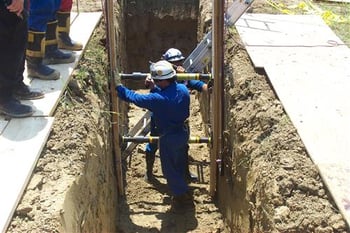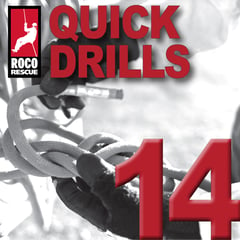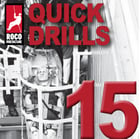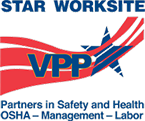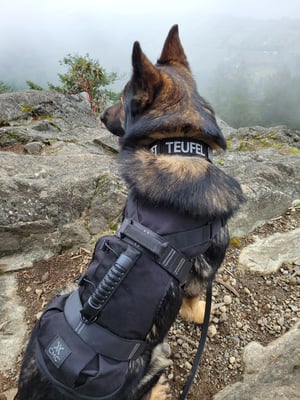
Throughout history, dogs have played a vital role in humans’ lives. Evidence of dogs coexisting and serving as companions to humans begins as early as 12,000 B.C. Today dogs continue to serve crucial roles in the military, law enforcement, and search and rescue (SAR), in addition to other more domestic duties.
With current technology, humans have become more mobile in modern times, so have their trusty companions. Dogs can now be found with their partners fast-roping out of helicopters, climbing up and rappelling down cliffs, or at the extreme end of the spectrum, parachuting out of planes.
All of these skills require a high level of training and experience for both dogs and humans alike. Military, police, and SAR working dogs, or K9s, must first go through rigorous obedience and job-specific training before moving on to advanced mobility skills such as rappelling and fast-roping.
Working dog teams provide unique capabilities that require an investment of time, effort, and money to develop. Like any important investment, K9s and the capabilities they provide should be protected. Any high angle rope work is high-risk. To mitigate this risk, using proper equipment and receiving professional training is paramount.
All of these skills require a high level of training and experience for both dogs and humans alike.
The first step to ensure the safety of K9s (and their handlers) during high-risk evolutions like rappelling is to utilize appropriate, properly fit, climbing or CE/UIAA certified equipment. Some organizations will dictate the specific gear K9 teams use while others allow their K9 teams to pick the gear that works best for their mission. For high angle rope access (climbing and rappelling), each K9 handler should have at a minimum: climbing or tactical helmet, correctly sized and rated harness, a means to descend rope (belay/rappel device), a means to ascend rope (mechanical ascender or prusik cords), safety lanyard, and several locking and non-locking carabiners.
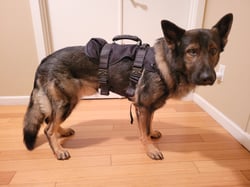 Finding a CE/UIAA certified harness for your K9 partner will be challenging or nearly impossible. However, dogs do need a properly fitting harness that is rated to a minimum breaking strength of at least 10 times the dog’s weight. Many working dogs wear vests that have a harness built in which can be acceptable, but plastic buckles that are prevalent on many K9 vests don’t cut it for rope access work.
Finding a CE/UIAA certified harness for your K9 partner will be challenging or nearly impossible. However, dogs do need a properly fitting harness that is rated to a minimum breaking strength of at least 10 times the dog’s weight. Many working dogs wear vests that have a harness built in which can be acceptable, but plastic buckles that are prevalent on many K9 vests don’t cut it for rope access work.
Additionally, there are many ways to attach the dog to the handler (or the rope itself), but again, any straps, cords, or carabiners need to be rated for climbing. For fast roping, the K9 team will need a fast rope descent device and the handler will need a helmet, harness, and gloves. One last piece of gear that some dogs may need for their safety, as well as the safety of their handlers, is a muzzle.
Any high angle rope work is high-risk. To mitigate the risk, using proper equipment and receiving professional training is paramount.
The second step to buy down risk and protect the investment that a K9 team provides during high angle rope access is to get professional training. It is also crucial that the dog has a high level of obedience before starting high angle rope work. Typically, the first order of business is to get the dog used to the harness and being suspended by hanging or hoisting the dog, gradually increasing the time the dog is suspended. Using treats or some other type of reward will help put the dog at ease. Done right, most working dogs will look forward to donning their harness.
This is also when you may want to introduce a muzzle in the same way (if the dog is not already muzzle trained). The use of a muzzle is not necessary for all dogs but is a good idea for high drive/high energy dogs or dogs that get nervous or agitated being suspended in a harness. The last thing handlers want while they are suspended by a rope is an agitated dog biting them, the rope, or any other equipment thus putting the K9 team at greater risk. Repetition is key; being deliberate and consistent with techniques in multiple environments and using rewards will ensure the dog is properly trained and socialized for the task.
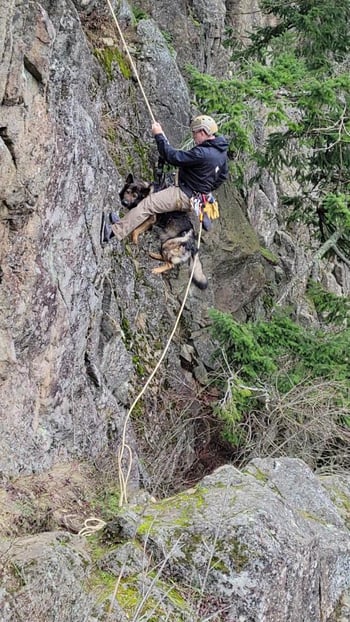 Once the dog is accustomed to the harness and being suspended, most of the dog’s training is done. For climbing and/or rappelling, the training curriculum a handler should undergo includes knot tying, anchor building, ascending and descending rope, belaying, and building and using mechanical advantage systems for hauling. Once a handler is confident and competent on the rope, the dog can be introduced.
Once the dog is accustomed to the harness and being suspended, most of the dog’s training is done. For climbing and/or rappelling, the training curriculum a handler should undergo includes knot tying, anchor building, ascending and descending rope, belaying, and building and using mechanical advantage systems for hauling. Once a handler is confident and competent on the rope, the dog can be introduced.
Military, law enforcement, and SAR K9 teams possess incredible capabilities that save lives.
Dogs are very attuned to their handlers, so if the handler is overly nervous the dog will sense that and feed off it. Additionally, there are several ways to position a dog while rappelling. The dog’s position is dictated by the situation and terrain. Some positioning such as to the side or between the legs will reassure the dog and enable the handler to negotiate obstacles more effectively.
Dogs will continue to accompany their human partners to places and in ways that weren’t previously thought possible. Military, law enforcement, and SAR K9 teams possess incredible capabilities that save lives. With the proper training and equipment, they can provide these capabilities in terrain and environments that can only be accessed with rope. Roco Rescue can provide both the professional training and the equipment necessary for K9 rope access be it by fast rope or climbing and rappelling.


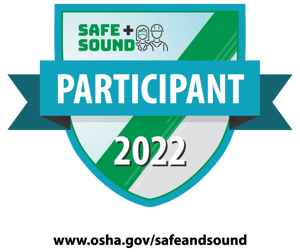

 4. Allow workers to lead trainings.
4. Allow workers to lead trainings. 

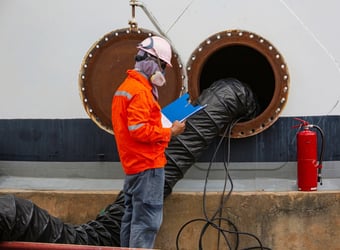
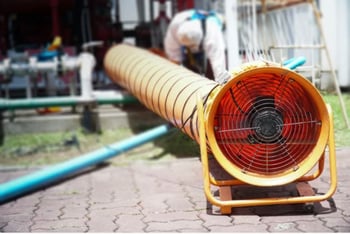 At the declaration of an emergency, deploying ventilation and performing air monitoring should occur concurrently with size up. Starting ventilation is like applying a cervical collar at the scene of an automobile accident; it is one of those things you know you are going to perform each and every time. And while it is expected that everyone will be appropriately trained, ventilation can be handled by support personnel while the rescue technicians are readying for entry.
At the declaration of an emergency, deploying ventilation and performing air monitoring should occur concurrently with size up. Starting ventilation is like applying a cervical collar at the scene of an automobile accident; it is one of those things you know you are going to perform each and every time. And while it is expected that everyone will be appropriately trained, ventilation can be handled by support personnel while the rescue technicians are readying for entry. Just as important as the fans is a solid air monitoring plan. The rescuers should be aware of the potential atmospheric hazards and have obtained the appropriate monitoring equipment. The air monitoring should continuously measure the entire space with results constantly provided to the vent team; this allows for adjustments if a particular part of the space is not seeing the expected improvements in air quality.
Just as important as the fans is a solid air monitoring plan. The rescuers should be aware of the potential atmospheric hazards and have obtained the appropriate monitoring equipment. The air monitoring should continuously measure the entire space with results constantly provided to the vent team; this allows for adjustments if a particular part of the space is not seeing the expected improvements in air quality.
